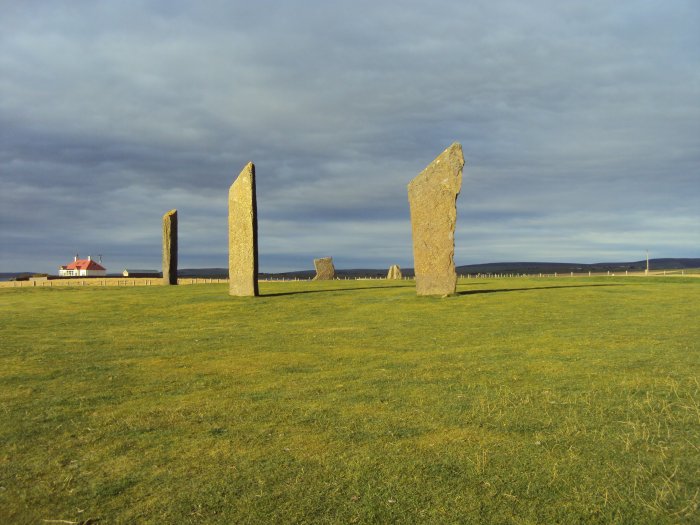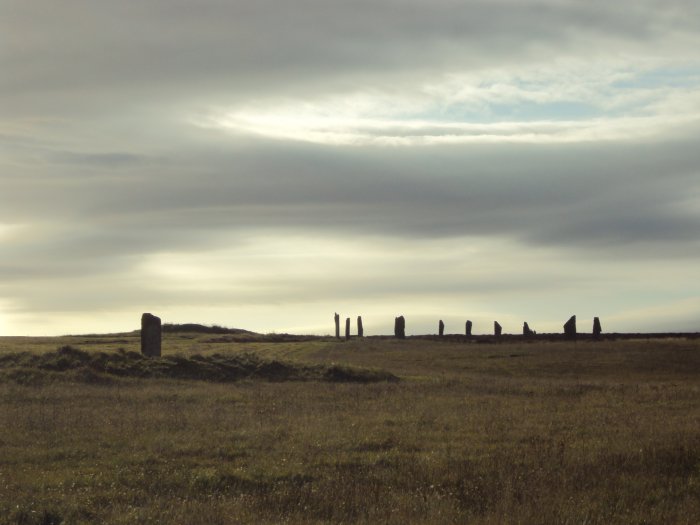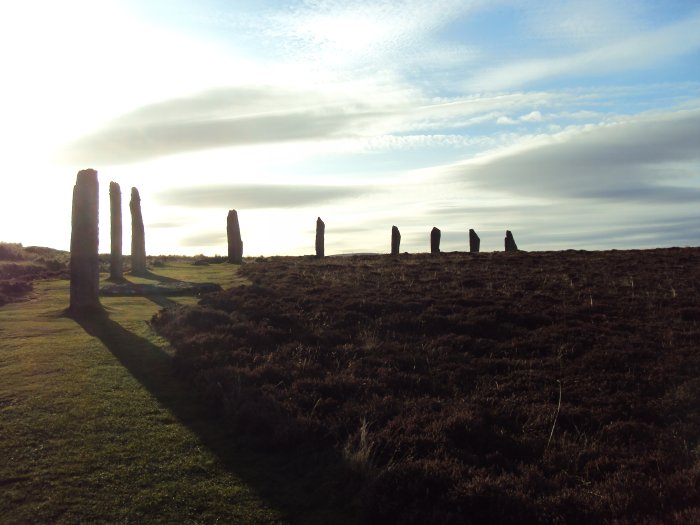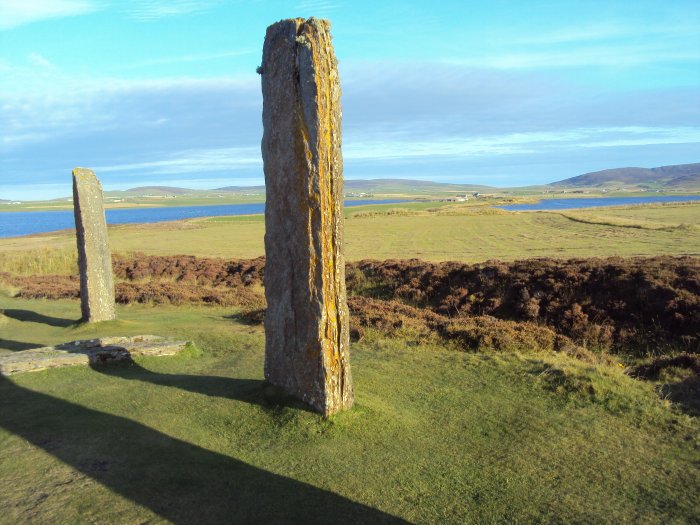I was eager to get to some of the key archaeological sites, so I hoisted my pack and set out on foot. I soon got a lift with a cheerful Orcadian, and was dropped off at the base of the narrow arm of land that separates the Loch of Stenness from the Loch of Harray. This was the most active center of Neolithic Orkney. It was but a short walk to the Stones of Stenness. These date from around 3000 BC. The physical setting, between two lochs and at the centre of a vast bowl of land surrounded by high, bare hills, is marvelous. I was beneath a particularly fine mix of sun and clouds, and there was nobody about to spoil the sense of mystery and awe.
I was now in the New York of the northern Neolithic. There is an astonishing density of contemporaneous sites, here, most dating from around 3,000 BC. To the immediate east of the Stenness Circle is the Barnhouse site. It was once thought that stone circles like Stenness were strictly religious or ceremonial structures, purposedly kept at a distance from domestic life. B ut Barnhouse proved to be an entire village, contemporary with the circle. Further to the east is Maes Howe. This extraordinary structure, beneath a large conical mound, 35 m / 115 f high, is a multi-chambered tomb, constructed with great skill. The central corbelled chamber is 3.8 m / 12.5 f high and the quality of masonry work is superb. Close examination reveals that it must have been the culmination of centuries of experiment and building experience, quite apart from the large scale of communal labour it must have required.
Scattered about the area to the south of the lochs are a number of isolated standing stones. The lochs are separated from each other by a narrow peninsula which protrudes from the northwest and almost reaches the southern shore. The gap is crossed by a causeway. Loch Stenness receives salt water from the sea, and Loch Harray reamins fresh. Thus, each provides a different selection of fish. If there were more extensive marshes in ancient times, the area would have provided a rich variety of fish and fowl. I was reminded of the Cree’s annual harvest of goose, in Canada, which could be depended upon whenever larger game failed to materialize, and which brought together families from a great distance. There were many birds audible and visible to me as I crossed the causeway. A family of swans glided by, a few metres from me, with serene dignity. A particularly fine stone stands at the southern foot of the causeway. At the other end, on the peninsula, two stones protrude incongruously from a the lawn of a farmhouse.
About a kilometre further on, the Ring of Bognar occupies a dramatic location on a high part of the peninsula. I would have to say that, situated as it is, Bognar is every bit as evocative of “sense of wonder” as Stonehenge is. The ring is huge ― 104 m / 341 f in diameter. Twenty-seven of the original sixty stones remain standing. The surrounding deep ditch is 380 m / 1,250 f in circumference. Whatever ceremonies took place there (and what these may have been changes with every fashion of speculation) must have been grand affairs. Attempts to decypher these monuments symbolically, with or without their relation to the landsape, usually amount to nothing more than guesses. Is the landscape divided into symbolic “sectors of the living” and “sectors of the dead” ? Sounds neat, but no real evidence can be pointed to. Astronomical alignments? One for Maes Howe is certaom. But alignments can be cooked up for any random scatter of stones, let alone a circle that is combined with isolated stones and an assortment distant landscape features. Attempts to see into the minds of Neolithic people and interpret their symbolism, values and behaviour tend to resemble the empathic insights of Deanna Troi in Star Trek TNG (“Captain, I sense ambiguity and caution in these aliens”). In other words, obvious platitudes, or arbitrary guesses.
The Bognar site moved me very deeply. The circle itself is magnificent, and its setting would have blown all the circuits of Byron or Charlotte Brontë. The sun alternately hid behind and broke out from rapidly moving clouds, creating effects that might have been planned by Sven Nykvist or James Wong Howe. There were no bored tourists, chanting hippies, or crystal gazers to spoil the moment. The only sounds were those of birds and wind. Such times of serious beauty don’t often happen in the cluttered ruckus of life.
As the day proceeded, I was able to amble unhurriedly among the archaeologically significant sites of Western Mainland. Skara Brae is an amazing place. I don’t decry the amenities that have been set up to handle the large number of visitors who have been inspired to visit it by books and television documentaries. After all, I’m one of that number, and not a professional archaeologist. It’s great to look with my own eyes at what I’ve seen in the books. The houses at Skara Brae show a people living on the remote fringe of Europe, far away from the supposedly sophisticated centres of the Ancient Near East, who could build skillfully and lived in more comfort than many an eighteenth-century cotter did. Periphery trumps Centre. But who these people were, what language they spoke, what they believed, and how much of the rest of the world they knew of, we don’t know. I’m inclined to believe that their world was conceptually large, that they participated in a broad network of travel and trade, and were not strangers to travel along the Atlantic seaboard, the North Sea, and the Baltic. The sheer mass number of structures they erected in the region is impressive, but it is the quality of the engineering that impresses most. These objects were not erected by savages or brutes.
As both the sunlight and my strength faded ― I was carrying a well-loaded pack ― I stopped rambling. Sleep, was a necessity. Above the farmed fields, the hilltops of Mainland are wastelands of gorse and heather. Fearing lightning, I did not perch atop one, but found an intermediate location to pitch a tent, and fell asleep to the lowing of cattle, the bleating of sheep, and irregular bluster of the wind.
* The largest island is called “Mainland”, a term which Orcadians never use for the mainland of Britain. They generally refer to the land mass to the south of them as “Scotland”.




0 Comments.